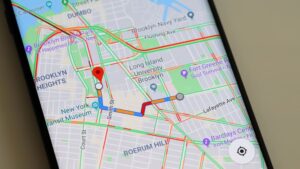Google Maps Will Now Suggest People Alternate Eco-friendly Routes

Google Maps has introduced a new feature that would direct the drivers to alternate routes that it renders to be the most eco-friendly on the basis of a number of factors.
It plans on highlighting the journeys and redirecting users to certain routes that it considers to be the more “eco-friendly”. This will be decided on the basis of the default route that possibly generates the least carbon footprint and this would be assessed by considering the factors like traffic data, congestion history, and the road inclines.
The globally known search engine declared that this feature would first launch in the US later in 2021 “with a global expansion on the way”.
This new feature is a part of the company’s efforts to fight rapid climate change.
After this feature is launched, the default route shown on Google Maps will automatically be the “eco-friendly” option as long as the drivers don’t deliberately choose an alternate route. Additionally, if there is an alternate route that is faster than the default route, Google will notify the driver and let users choose a route of their liking. Google will also inform the users of estimated emissions on both routes.
The director of product at Google, Russell Dicker said “What we are seeing is for around half of routes, we are able to find an option more eco-friendly with minimal or no time-cost trade-off,”.
Google, which is owned by Alphabet Inc, announced that it utilises emissions data based on testing out various types of cars and road types, and makes use of information from the US government’s National Renewable Energy Lab (NREL).
Siddharth Pathak, a partner at consultancy firm Kearney also claimed that this would be a good example of three different trends merging together – data, sustainability and consumer choice. Along with this, it will also encourage people to consciously choose speed over sustainability and often cost.
The trade-off
For this new feature or route plan, Google plans on using the emissions data which is based on testing various types of vehicles and roads in the United States and consequently surmised that for almost 50 per cent of the surveyed routes, there was an alternative way to offer ‘greener’ routes without any crucial tradeoffs.
Russell Dicker, a director of product at Google also claimed the same in an official statement saying that they have observed that there is a possibility to find and offer a considerably more “eco-friendly” alternate route without costing minimal or no time.
Zone warnings
Along with the previously discussed feature, the search major also announced that from June, it will begin cautioning drivers who have decided to travel through low emissions zones about the certain vehicles that are restricted in that zone. This warning feature will be pretty common in countries like France, Germany, Spain, the Netherlands and the United Kingdom.
Google also announced in its blog post that numerous cities and zones from Amsterdam to Jakarta and all similar cities across the globe have set up certain low emission zones and in these areas, there is a restriction on certain polluting vehicles like some diesel cars or cars that possess particular emissions stickers in order to keep the air clean.
In order to support these efforts being made in the favour of the environment, Google is also working on notifying the drivers in order to assist them better in understanding what are the restrictions while they are travelling through one of these zones.
Google Maps will also allow its users to be able to compare various types of alternative travel options like a car, cycling and public transport while navigating in one place instead of switching between separate sections in a new feature that will be launched this year.
The famous tech giant claims that it has adapted and developed sustainable practices in order to benefit the environment, and it has committed to becoming carbon-free by the year 2030 in order to help cities track greenhouse gas emissions.

